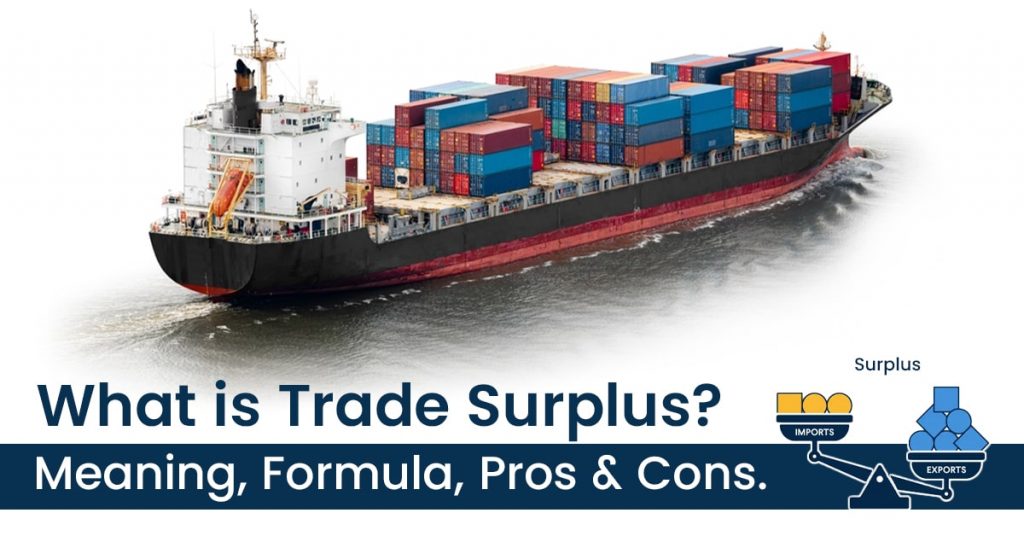
A trade surplus signifies a favorable trade balance, where a nation’s exports exceed its imports. This condition is determined by a simple computation:
Trade Surplus = Total Value of Exports − Total Value of Imports
When the result is positive, indicating that a nation exports more than it imports, a trade surplus exists. Conversely, when the outcome is negative, indicating greater imports than exports, it results in a trade deficit.
The reliability of the Trade Balance as an indicator of a nation’s economic health depends on various factors. For instance, during a recession, a nation might intentionally boost its exports to stimulate consumer demand and increase employment opportunities. However, such strategies may backfire if the nation resorts to trade protectionism, such as imposing tariffs or quotas, to maintain its trade surplus. These actions can lead to retaliatory measures from other nations, sparking trade wars that ultimately harm the economies involved.
Understanding the Concept of Trade Surplus
A trade surplus can increase employment and economic growth within an economy, yet it may also lead to pressures related to inflation and higher interest rates. Furthermore, the international value of a nation’s currency can be significantly influenced by its trade balance, as it allows the nation to trade away a substantial portion of its currency.
The impact of trade surplus on a nation’s currency strength compared to other currencies is variable and depends upon factors such as the volume of goods and services produced domestically compared to those of other nations, as well as prevailing market conditions.
A trade surplus signifies robust demand for a country’s products in the global marketplace, leading to increased prices for such goods which directly makes our domestic currency stronger. Additionally, a trade surplus indicates high demand for a nation’s goods and services abroad, which typically results in price appreciation and further supports the strengthening of the national currency.
Significance of Trade Surplus
While a trade surplus can stimulate job creation and economic growth, it may concurrently drive inflation and elevate interest rates. Moreover, a nation’s trade balance, facilitating the export of a significant portion of its currency through trade, can wield influence over its currency’s value in global markets.
A trade surplus often has the effect of reinforcing a country’s currency against others, thus impacting currency exchange rates. However, this outcome hinges on various factors, including the quantity of a nation’s goods and services relative to those of other countries, as well as prevailing market dynamics.
Trade Surplus in India
The Ministry of Commerce and Industry releases India’s trade balance data in US dollars, with the International Monetary Fund serving as the data source until April 1990. In December 2019, India’s trade balance exhibited a deficit of USD 11.3 billion, marking a decrease from USD 12.2 billion recorded the previous month.
Monthly updates on India’s trade balance statistics indicate an average deficit of USD -369.7 million from January 1957 to December 2019. The latest statistics reveal that India’s total exports in December 2019 amounted to USD 27.4 billion, representing a 1.6% decline compared to the preceding year. Conversely, total imports in December 2019 stood at USD 38.6 billion, reflecting an 8.8% decrease from the previous year.
Over the period from 1957 to 2022, the Balance of Trade in India has maintained an average of around -3.21 USD billion. It reached its peak at 0.79 USD billion in June 2020 and hit a record low of -30.00 USD billion in July 2022.
Comparison Between Trade Deficit and Trade Surplus
A trade deficit stands in contrast to a trade surplus. Typically, currency exchange rates respond inversely to a trade deficit. When imports surpass exports in international trade, there tends to be diminished demand for a country’s currency, resulting in its depreciation in overseas markets.
Although trade balances often wield considerable influence over currency fluctuations, governments can implement measures to mitigate their significance. Among these measures is the adoption of a pegged exchange rate, which maintains a fixed exchange rate for a nation’s currency.
In contrast, a currency’s exchange rate is considered floating when it is not pegged to another currency. Floating exchange rates, prevalent in the currency market, one of the largest trading arenas in the global financial system, are highly volatile and susceptible to daily trading sentiments.
Is Trade Surplus Beneficial?
Traditionally, selling more than buying is considered advantageous. A trade surplus signals strong demand for a nation’s goods, potentially resulting in increased job opportunities and accelerated economic expansion. However, it’s important to note that countries with trade deficits are not necessarily in a precarious situation. Each economy operates uniquely, and those with a history of importing more goods, such as the United States, often have valid reasons for doing so.
Advantages of Trade Surplus
Among the lists detailing the nations with the largest trade surpluses and deficits, one can observe representation from some of the strongest economies worldwide.
Here are several benefits associated with a trade surplus for a nation:
1. Job Creation
A trade surplus signifies heightened domestic production of goods and services, leading to increased employment opportunities.
2. Additional Resources for Investments
Nations with a trade surplus have extra resources at their disposal. This surplus can be utilized to modernize various sectors and businesses, thereby enhancing productivity.
3. Reduction in Government Expenditure
With surplus funds available from trade, businesses, and industries require less financial support from the government. This surplus public money can then be redirected towards infrastructure improvements, benefiting the nation.
4. Enhanced Foreign Reserves
A trade surplus contributes to an increase in foreign reserves, providing a buffer against external economic shocks. Accumulating foreign reserves enhances a nation’s ability to stabilize its currency and manage its balance of payments effectively.
5. Infrastructure Development
Surplus funds from trade can be allocated towards infrastructure development projects, such as transportation networks, communication systems, and energy facilities. Improved infrastructure enhances economic efficiency, competitiveness, and overall quality of life for citizens.
Disadvantages of Trade Surplus
While trade surpluses offer advantages, they can also pose challenges to an economy:
1. Higher Inflation Levels
Trade surpluses may lead to increased prices, thereby fueling inflation. This phenomenon occurs when the economy experiences more demand than supply, resulting in a decrease in the value of money.
2. Economic Challenges if Trade Surpluses Diminish
High net exports, indicative of trade surpluses, can strain national savings. When a surplus of goods floods the market, maintaining stable inflation rates becomes challenging. This reliance on exports for economic stability can make it difficult to implement adjustments in other economic sectors, potentially leading to financial crises.
3. Natural Resource Degradation
Some nations heavily rely on natural resources as their primary export commodities. While these resources can be lucrative exports, their extraction and exportation can lead to ecological damage and depletion of natural reserves over time.
4. Trade Protectionism Risks
Persistent trade surpluses may invite protectionist measures from trading partners, such as tariffs, quotas, or trade barriers, aimed at reducing imports and rebalancing trade. Trade protectionism can escalate into trade disputes and undermine international trade relations, potentially leading to retaliatory actions and trade wars.
5. Dependency on External Demand
A heavy reliance on exports to maintain a trade surplus exposes the economy to fluctuations in global demand. Any slowdown or downturn in global demand for a nation’s exports can significantly impact its economic growth and stability, particularly if domestic demand cannot compensate for the decrease in external demand. This dependence on external demand can make the economy vulnerable to external shocks and economic downturns in key export markets.
In general, people prefer it when a country exports more than it imports. But sometimes, politicians talk about protecting local industries, which can cause problems like trade conflicts and tariffs.
People often think that those who import goods are at a disadvantage during times of international tension. However, this isn’t always true. Sometimes, importing goods can help a country’s economy, especially when countries get along well.
Despite what some may think, many of the world’s biggest economies import more than they export. This challenges the idea that importing a lot is always bad. If you’re interested in learning more about international trade, you can check out iiiEM – Export Import Course in India. They offer courses to help you understand how global trade works and how to succeed in it.
